#bobbinbugs originals
Explore tagged Tumblr posts
Text
Entrapment: marriage, sacrifices, and gilded cages in Silksong
This is a massive, fully-sourced essay encompassing all the marriage symbolism we have for Silksong and the full breadth of its connotations. This thing is a beast in five parts: mind that readmore!
Part 1: a presentation of evidence
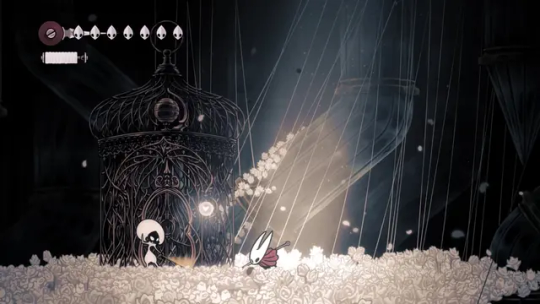
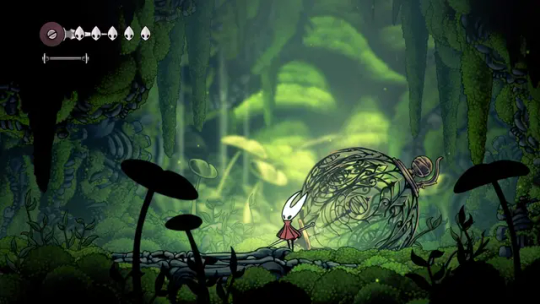
Rather than diving right into analysis, we need to set the stage with information gathered and analyzed by the talented people of the HK tumblr community, to whom this would not be possible without.
Hornet starts the game captured in a gilded cage, carried off by small, faceless creatures in white. as pointed out by ganymeadesclock, these characters are most likely religious figures, and Lace, while not one of the cultists, is most likely associated with them... somehow.
Furthermore, marriage symbolism. I won't reiterate myself overmuch, so look here, here, and here for various pieces I've managed to collect. No matter how you slice it, Lace is absolutely drowning in marriage symbolism, right down to her name. It does feel quite notable, then, that Hornet and Lace have similar cages, don't they? Lace's quite strongly resembles a decorative birdcage, actually, and Hornet's a fishbowl; (Aside: though the latter is a bit of a stretch.) enclosures too small to support an animal's wellbeing, but perfect for displaying them. Almost like, perhaps, a trophy bride?
Part 2: marriage as a gilded cage
This was going to have a excerpt from my essay on the unicorn tapestries, but it's already long enough as is. This segment and the following cannot analyze Silksong directly due to lack of information, but we can draw throughlines from the classic and epic literature Team Cherry draws inspiration from, and the history surrounding them.
Marriage has traditionally been a transfer of property throughout much of our world, not an act of love between two consenting parties. While a married woman would have the freedom to manage her husband's property in his absence, when he was around, she belonged to him; in marrying, she transfers from her father's ownership to her husband's. Marriage has been a total sacrifice of freedom for a woman in exchange for her "safety," which, considering how difficult it is to leave domestic abuse (Aside: Even more so in the times where woman could not own property or money, and divorce was not legal), is a perfect example of gilded cage.
This is a summary, and I recommend checking out these pieces on marriage abolition and medieval marriage culture for further context. Primarily, I'm trying to convey a certain degree of dread to emphasize why Hornet may be running herself ragged in Pharloom: her freedom may be deeply at stake.
Aside: There's also a throughline of queerness and the imprisonment of heterosexual marriage, and how it may relate to Lace attempting to free her and why Lacenet could be both canon and fascinating, but I won't delve into it here.
Part 3: A foray into ancient greece: marriage as a sacrifice
If you're a Greek mythology nerd like me, you may have noticed an odd connecting thread between Persephone, Psyche, and Antigone. All three are connected by their status as young virgin brides, but also by perversion of marriage rites in their stories. Persephone is abducted to the underworld (the land of the dead) and bound forever to a man via eating pomegranate seeds: a symbolic "seeding" (read: impregnation) if you will. Psyche, when taken away to be married, has instead funeral rites conducted for her, and she spends her honeymoon afraid of the invisible monster she married. And last, Antigone, the death-bride marching towards her funeral-wedding, thigh to thigh with her brother in the grave.
Present along the same thread is imagery of distraught mothers and sisters: Persephone's mother grieves and wails and sets a blight on the earth searching for her daughter; Psyche's sisters weep to leave her on the rock; Ismene tries to share the blame of Antigone's crime, punishable by death, so she would not be without her sister, or vice-versa.
A few feminist interpretations have been offered, but the most common is that to a Grecian mother, her daughter has been taken away from her home, never to be seen again. A marriage, to a sister or mother, is a sacrifice: A young girl is taken away from the comfort of her household into a scary, unfamiliar world, where she must learn quickly about herself and her body without the guidance of people - particularly women - she knows and loves.
Don't forget, either, that rape did not initially refer strictly to sexual assault, but the act of kidnapping a girl as a marriage rite. (Aside: The bride's consent does not matter; only her father's. Why do you think the term evolved to mean sexual violence?)

Sound familiar?
And the perversion of the marriage rite doesn't end there. Churches, a notable location in Pharloom, don't just marry people; they are also where funerals are conducted. And, if you listen to the Silksong trailer, you will hear the Dies Irae - the Funeral Mass - note for note.
But the perversion of the rite does not end there. Even more disturbing is the presence of consumption as a theme. As I said here:
Oh I am THINKING about Silksong tonight... How Lace says “Poor little morsel” and “delicious,” implying not only Pharloom would consume her, Lace is on the side of what’s doing the consuming. How spiders frequently feed on their own kind, especially in massive community web systems... whatever’s up with Pharloom, it’s going to eat Hornet alive.
A sacrifice, in its most traditional sense, is to give a deity sustenance, at an expense, in exchange for the prosperity of the many.
Part 4: Lace as Κανηφόρος and her religious duties: wild speculation!
Let's revisit Lace as a religious figure - and a potentially important often. If Hornet is the sacrifice, what does that make Lace?
From wikipedia:
The Kanephoros ... was an honorific office given to unmarried young women in ancient Greece, which involved the privilege of leading the procession to sacrifice at festivals ... The role was given to a virgin selected from amongst the aristocratic or Eupatrid families of Athens whose purity and youth was thought essential to ensure a successful sacrifice. Her task was to carry a basket or kanoun (κανοῦν), which contained the offering of barley or first fruits, the sacrificial knife and fillets to decorate the bull in procession through the city up to the altar on the acropolis. ... A girl who acted as kanephoros would have advertised the central place of her family in Athenian society, and her own availability for a dynastic marriage.
Wait, up through the city? That sounds...
Hornet, princess-protector of Hallownest, finds herself alone in a vast, unfamiliar world. She must battle foes, seek out allies, and solve mysteries as she ascends on a deadly pilgrimage to the kingdom’s peak.
...Awfully familiar.
And, interestingly, whatever ritual centering around Hornet we're spiraling towards, Hornet seems to be willfully - if unknowingly - marching towards it, and Lace seems intent on stopping it in its tracks.
I suspect she will not only be the rival won over role, but the betrayer. Lace is not to be wedded, but Hornet. Lace's role is to sacrifice Hornet at the proper time and place, and her goal before then is to stop Hornet from doing so, by any means necessary.
The final battle will almost certainly involve Lace, and in the worst ending, she will most likely be the one to deal the final blow and complete the rite. We're in pure speculative territory, but we already have the visual symbolism that Lace is just as trapped as Hornet. What is a betrayal if not duty, or a desire to save her own skin, winning over compassion?
Part 5: Disclaimers, Clarifications, and Conclusions
This is not to say I think this will be a recreation of Grecian ritual. Far from it: I don't even claim that marriage and misogyny will be a theme in anything other than visual symbolism, and I strongly doubt hornet's skill and status will ever be disputed due to her womanhood. Simply not Team Cherry's style! Until Silksong comes out, this is mere extrapolation.
But through Team Cherry's strong visual storytelling, I feel confident drawing allusions. The crushing prison of gilded cages, the marriage imagery, the subtle perversion of rite in the trailer, all spells out one thing:
Hornet is to be married or sacrificed.
But then again, what's the difference?
A special thank you to the minds of @ganymedesclock, my mutual @rukafais, and @ruthlesslistener, whose analysis was crucial to piecing this massive theory/analysis together. And for my mutuals who might be interested: @voidsiblings, @halloween-cats, @imminent-danger-came, @croissantk, @electricabsolution, and @toapenguin
#lace#hornet#lacenet#silksong#hollow knight silksong#hollow knight meta#silksong meta#meta#bobbinbugs originals
32 notes
·
View notes
Text

Ok mrs @guildedpin, this post has been rattling around in my head since I’ve seen it tonight and would like to take the opportunity just to make a List. (Don’t worry about who you’re married to, I just think mrs looks better than ms.)
Something something wedding bells, as you’ve said (though I’d like to mention they play the Dies Irae, which is a funeral song, but big bells, churches, etc et cetera.)
Lace’s hat- as pointed out in another post, her hat looks like a Japanese wedding garment. Given more weight by the fact her VA is Japanese. (Coincidentally(?) so is Hornet’s!)
White roses in Lace’s second arena. Enough said.
The color white in general and its association with Lace, and the wazungu connotation of white with weddings. Heck, lace itself is common in wedding gowns.
WHAT DOES IT ALL MEAN. Is Lace going to marry Hornet? Combining the gilded cage symbolism and her likely association with the church/higher power, is Lace a valuable member of Pharloom in an arranged marriage? Are we (tl: am I) reading too much into this entirely? WHO KNOWS.
silksong isnt a prequel because hornet doesnt have a wedding ring on
#find out next time on hollow knight: silksong!#silksong#meta#lacenet#does not change that the connotations are there no matter how speculative this is#(lace voice) we all know a final act can only end with a wedding or a mass slaughter-#-and the way she looks at me I don’t like my odds#kinda#analysis#the 100 crowd#bobbinbugs originals
233 notes
·
View notes
Text


In preparation for an upcoming post, here's some meta on its own. Pictured on the right is a traditional shinto wataboshi, basically a bridal veil. It's sometimes mixed up with the tsunokakushi, a headdress meant to hide the "horns" (jealousy, pettiness, and cruelty) of the bride and confirm her goal to be an obedient wife, but it looks quite different:

Between this symbolism and her evident personality, if Lace is a bride, she is not a compliant one.
#silksong#bobbinbugs originals#lace#silksong meta#hollow knight#hollow knight meta#hollow knight silksong
8 notes
·
View notes
Text
Quirrel was not suicidal
As a 3-year hollow knight fan, I see "Stag Beetles and Broken Legs" get recommended a lot. A lot a lot. Considered by many to be the definitive Hollow Knight fanfiction, it generates fanart and gushing recommendations every time it's mentioned.
But there's one glaring issue of interpretation I've gathered: It frames Quirrel at the Blue Lake as suicidal.
And I don't think that's correct at all.
Once you get down to it, everything in Hallownest is about death and avoiding it. The Pale King's eternal kingdom, the Soulmaster's shaping of soul, the Radiance's aimless reanimated vengeance... in clinging to life, they strip themselves of dignity, and cause unfathomable suffering for naught. Characters who think they will never die, like Tiso, meet their unceremonious end, unburied and unmourned. "All things must accept an end," in the words of Vespa's ghost.
A minor character reiterating one of the central themes of the game: hold that thought.
Few characters have immortality aside from gods. Even with gods, immortality is highly conditional: but that's a different essay. In otherwise "mortal" characters who lasted too long, they seem ghostlike themselves: the pale mourner evokes the classic white lady archetype, and dissipates into thin air once her business is finished. The seer appears to have a conditional immortality as well: once the maximum essence is collected, she, too, dissipates, having finally assured a new Wielder has come.
Quirrel seems to operate on this conditional immortality as well. Considering he left long enough ago for the plan to be put into action, the fail of it, and for the fallen kingdom of Hallownest to become "ancient". Like the Mourner and Seer, he probably should have reached the end of his natural lifespan long, long ago: and, as we see Monomon's mask protect him from killing blows in the prequel comic, it's fairly logical to conclude it's also extending his lifespan. No point in creating a back-up plan if the back-up isn't protected, right?
And what happens if you remove the lifesource?
Well... let's put it this way. "I begin to feel my age" takes on more weight than a quip about how much time has passed, or the burden of memory. Without Monomon's protection, his statement metamorphoses into an admission: Quirrel is starting to feel, body and mind, that his artificially-extended lifespan is catching up with him.
So that's the first half: accepting death. The second half is fulfilling your purpose for living: Let's talk about the Nailsmith.
The Nailsmith is a character who lives to forge nails. That's his art and purpose: to forge a Pure Nail. Once his purpose is completed, he loses his will to live: after all, it's completed. The way the ghosts pass on, and how Ghost too disappears when their purpose (defeat the radiance) is completed, the Nailsmith asks the player to kill him. Even his thoughts revolve around his worthlessness. His dream nail dialogue reads "My life's work achieved… What more is left…?" To the Nailsmith - and the oligarchs of the game - completing your purpose means you have outlived your usefulness. But there is a key difference between the Nailsmith's final* thoughts and Quirrel's final thoughts. For comparison:
"All tragedy erased. I see only wonders..."
This is not the dialogue of a suicidal person. Quirrel is not self loathing. He doesn't feel worthless. He's grateful for the long life he's lived, and the blessing that he gets to experience it twice over. And this is his dream nail dialogue: it's objective truth he's not putting on a brave face but harboring darker thoughts. Genuinely, I would not call these the thoughts of someone who wants to die: this is the thought process of someone who wants to live. You may extrapolate or choose to ignore, but I don't think it's founded to interpret Quirrel as suicidal.
And that establishes difference between the Nailsmith and Quirrel: Quirrel doesn't seem burdened by his lack of purpose. In fact, I don't even think he considered Monomon his purpose to begin with. We know from the Nailsmith that fulfilling your purpose means you've outlived your usefulness; you die, or you find a new purpose. But the Nailsmith's purpose was smithing nails, and he devoted himself to it. Quirrel is called back to Hallownest, but spends 90% of his time in it just... fucking about, to put it crassly. He does want to solve the mystery of his being called, but he takes his time. He doesn't consider his purpose is to serve Monomon; he's not overtaken by a passion or skill; Quirrel is a traveler. He's just after the wonders.
At the end, he does exactly that. He lived a long, full life for himself and no other, seeking out wonders and taking his time. He finished what he was called to do, but it's telling even his final goal - seeing the Blue Lake - is a goal for himself, and not something he was told to do. He spent most of that long life not knowing he had a purpose someone else set, and doing what he wanted.
(quirrel voice i was put on this earth to accomplish 1 thing but i forgot what it was so thankfully i can do whatever i want)
Despite his final thoughts being of someone who loves living, Quirrel is... almost absolutely dead. The file is called quirrel_death_nail.png. One of his first lines in the game is advising you to loot weapons from corpses, because the dead "shouldn't be burdened with such things," and the last sign of him is his abandoned nail. Furthermore, he abandons his nail at the time Hallownest is most dangerous, with the Radiance so close to being free. Self defense is more important than ever, and a character as wise as Mr. Either-you're-alert-or-you're-dead wouldn't abandon his nail at such a crucial moment! Overall, Hollow Knight is a game that keeps in the classic tragic opera tradition of killing off as much of its cast as possible before the final curtain, and Quirrel is no exception. You can argue that quirrel_death_nail.png is the death of "Quirrel the wanderer," but I'm not going to lie, the signs aren't in looking good.
But I don't think he drowned. Just for fun, let's bring a common fan interpretation into the fray: Quirrel is commonly interpreted as a pillbug. (So do I - it's just too perfect.) Neatly, pillbugs are actually crustaceans, and have gills! Given the general aquatic theme of fog canyon and his final stop at blue lake, the effect is less "giving up" and more "return to homeland/true nature," which is what Quirrel's arc is all about. I wouldn't worry about him drowning.
But if he's dead, and his last stop was at Blue Lake, but he didn't drown, what did happen to him?
Remember the Seer and Pale Mourner, and their conditional immortality? Keeping in line with the other ghosts-that-haven't-died in the resting grounds, I like to think Quirrel, upon completing his task, likewise fades into light. The location, lack of clarity between immortal, alive, or dead, and completion of unfinished business all line up for Quirrel to go the same way. This idea is a bit more of a stretch than all the others, but I believe it suits him. It's fair. It's graceful. It's direct contrast to an unburied corpse or an unmarked grave, like all the Fools at Kingdom's Edge.
So, In conclusion: Quirrel didn't drown himself. He doesn't think he's worthless or that he doesn't want to live. He saw his time is up - and perhaps had been up for a while - and does not scrabble or cling, but bows out with grace. In turn, the wandering scholar earns the rarest jewel in all of Hallownest: a dignified passing.
Rest in peace, Quirrel. You've earned it.
#anyway this is why i refuse to read sbabl#aside from the complexes#quirrel#meta#bobbinbugs originals#hollow knight meta#hollow knight#long ass post. made this while depressed#bon appetit#UPDATE FIXED A GLARING ERROR OR SIX#TUMBLR SAVED IT WEIRD AND LEFT BEHIND A COPYPASTE I DELETED. OOPS OOPS OOPS#in tumblr's defense firefox was crashing a lot for no reason that day
99 notes
·
View notes
Text
hornet does not get flustered, ever. ok? she doesn't blush and she doesn't freeze up. she'll think about her rival getting all up in her face, blowing a kiss, etc at 3am and her gaze will harden and be like 'hm. this is hatred. i have to kill her'
#lacenet#headcanon#it's extremely hard to tell even from an outside perspective that she has a crush!!!#her wires are hella crossed from all the trauma#silksong#and the autism as well#her modes are 'attack' and 'probably don't attack'#with a hefty side of emotional repression#(hornet internal monolouge) she blew me a KISS... she was trying to HUMILIATE me...... I MUST DEFEND MYSELF. (takes a bullet for lace)#(multiple times)#forge-daughter: that is not hatred. (thumbs up) good luck girl#lace finally is like ok. i'm pinning you against the wall because i want to kiss you. do you need a moment#and hornet has to process that information & unpack her shit for like 3 days before she comes back deciding that sounds nice actually#bobbinbugs originals#hornet
117 notes
·
View notes
Text

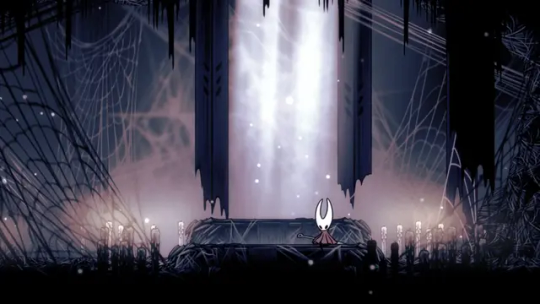



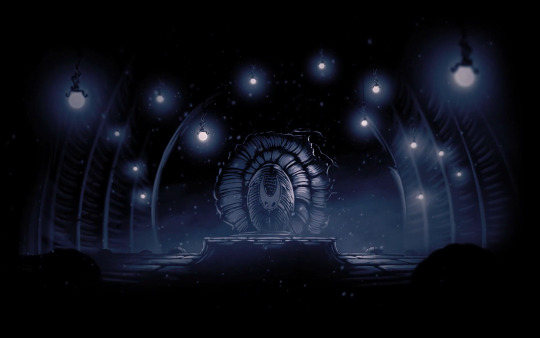
Anne Carson, Antigonick / Team Cherry, Hollow Knight.
#the visual similarities here. woof.#hornet#hornet hk#hornet silksong#meta#bobbinbugs originals#silksong#holow knight meta#hollow knight#hk meta#heaaavily inspired by an rgu post formatted the same way!#lace#antigone#antigonick#anne carson
43 notes
·
View notes
Text
what if you saved me from my gilded cage. and it was mutual. and we were both girls
9 notes
·
View notes
Text
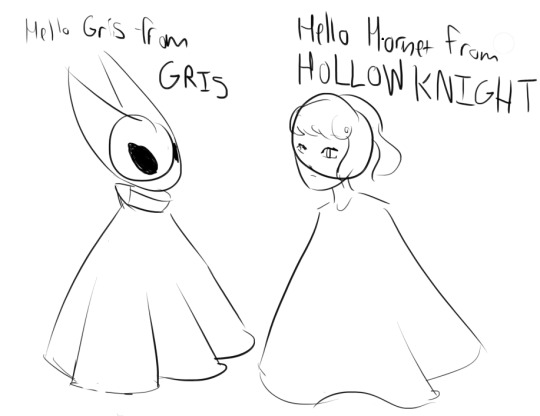
GIRLS WITH CLOAKS AND GRIEF-RELATED FAMILIAL TRAUMA GANG
46 notes
·
View notes
Text
Hornet is not a very angry or quick to anger adult, but I stand by her being an extremely angry child. If the kingdom you were born to protect was falling to ruin from a magic plague and you watched your family dwindle away 1 by 1 you’d be a pretty fuckin angry kid too
#she learns to wear grim inevitability with grace but I’ll bet she went down that path kicking and screaming#bobbinbugs originals#hornet#headcanon#hollow knight
21 notes
·
View notes
Text
Bad end: full on queerbait, lacenet has almost no subtext in the game and Lace dies at the end, subtext is with different characters, the marriage imagery is lace in an arranged marriage and nothing else or was totally accidental
Good end: the best ending is locked behind lace and hornet’s wedding, gamer dudebros die mad, most epic W for lesbians since korrasami
14 notes
·
View notes
Text
Hornet is just so. She was born to protect but how do you protect something that’s rotting?
16 notes
·
View notes
Text
For a character so marketable-plushie shaped, it is astounding and saddening there is no marketable plushie of hive knight.
10 notes
·
View notes
Text
Something fun: most of the area themes are rearrangements of the title theme, and the soul sanctum follows the same chord progression and melody as CoT in a minor key
14 notes
·
View notes
Text
Hollow’s tragedy is that they were always fated to fail. Hornet’s tragedy is that she has to live on. Ghost’s tragedy is that they have to die at the end of Dream No More, for some reason
#bobbinbugs originals#seriously. what’s up with that#ghost did not have to die at that ending and bel I was confused when I first read that’s how the cutscene went#I could do an analysis but I have to prep the house for a guest and cooking#ask me later#hollow knight
18 notes
·
View notes
Note
HII so what do you mean about vessel OCs being thematically relevant? Did you mean specific OCs or the concept of making a vessel OC in general? either way i would love to read your thoughts
An ask! Anon, may you be blessed evermore. Thank you!
As for thematically relevant vessels, well… that’s kind of two separate questions! I’ll go with the general question for now, because that’s way easier to answer, but frankly I’m going to devolve into rambling and start talking about my little guys. You’ve been warned!
A lot of people just want to make A Guy and give them a story, with the backstory of the vessels as a base. And that’s all well and good! It’s lovely and compelling, and I support that. But hollow knight has a strong theme of family. You can connect a lot of the themes from there: duty in the name of your parents, having to unfairly fill a sibling’s shoes, the idea you’re one of many, the desire to reconnect despite everything: it all comes down to the fact that the 3 main characters are related.
All the vessels are a part of a family, and all save one are very young children at that. Either by luck or sheer solemn brutality, ghost managed to rough it on their own. But all of hollow knight is the story of those three siblings trying to connect with each other, and never fully bridging the gap: often, people design vessels in isolation, but I find it most interesting if they come in droves. Ghost, Hornet, and THK are an emotionally-estranged set. How would they react to a set of vessels who work together?
(I’ve seen this idea explored by @talos-the-mourning-vessel, which is probably why they’re my favorite vessel oc to date!)
In turn, I’m using this segue as an excuse to talk about my little guys.
I have two little guys, basically intended as self-inserts of myself and @two-children-in-a-trenchcoat (hi buddy!) and intended for a multiplayer true end let’s play that probably isn’t going to happen. Welp. Regardless… these two sealed their fates in the abyss/birthplace, where they helped each other up instead of killing each other. Canonically they went up the wall closest to the door (not the middle platforms) and pk was facing the wrong way and didn’t notice. Pk moment
They then decide “this entire kingdom sucks we need to leave NOW” and do exactly that, returning when they hear hollow scream, same as ghost. They then show up 15 min late to hallownest with Starbucks.* Their asses are not saving hallownest ‼️‼️
They don’t have the guts, resolve, or skill that Ghost does. Their main survival skill is being quick to retreat and having the other’s back.
I really love these guys because of how they interact with ghost: or, should I say, ghost hates them. Hollow knight, as is always worth reiterating, is the story of 3 siblings trying to reach for each other and never quite bridging the gap. Seeing their family actually act like family: always willing to help the other up & totally ride or die would be such a gut punch to Ghost.
There’s also hungry knight, which is the story of hk in extreme miniature, but missed the central emotional core and implied story behind “I carried a fallen companion to a resurrection altar (because they’re so fundamental to me I can’t continue without them)” that didn’t fully make it into hk. (that implied story was the only compelling part about hungry knight tbh. I love to see extreme hk beta but let’s be real. It’s not good.) I like the idea, and these two continue that dropped thread in a way that doesn’t undo ghost’s whole “lone warrior” vibe. Not even a vibe, it’s a theme: they were refused a helping hand from the very start. They crawled out alone, they returned alone, they take on the burden alone. These two won’t save the world, but they have each other, which rubs everyone in hallownest the wrong way, probably.
These are all my miscellaneous thoughts on the matter, really! Thank you for asking. I ought to draw my little guys sometime.
*I think they have their reasons. Partly fear, partly arguing, partly distance. They have no more memories than ghost, but know they wanted to leave the call’s origin so badly it sent them running blindly into the wastes. They finally came ‘round from the appeal/duty of there being another like them, but they were very avoidant to return.
6 notes
·
View notes
Text
the reason ghost is so small is that they had only just gotten out of hallownest when hollow screamed. they got far enough to lose their memories & immediately turned back around
3 notes
·
View notes